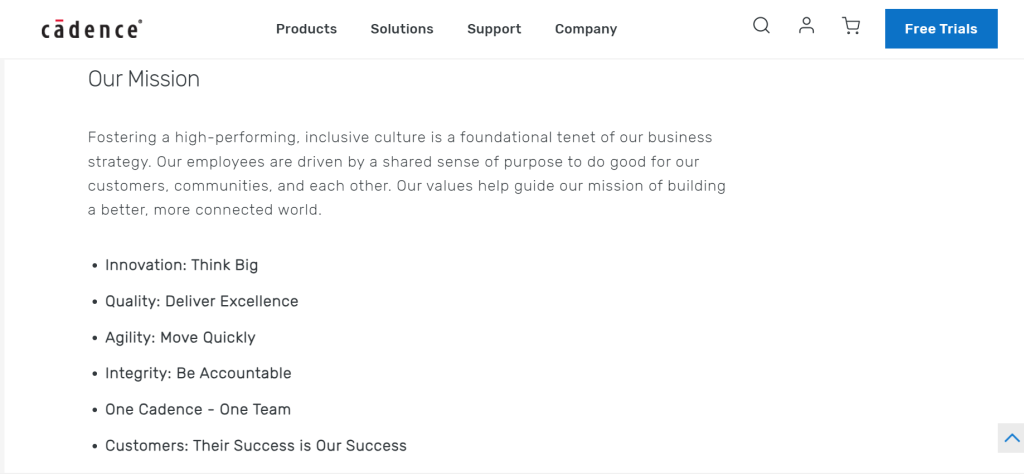Table of Contents
ToggleA Brief History of Cadence
Cadence Design Systems, Inc. was founded in 1988 by Jim Solomon, James D. Plummer, and Alberto Sangiovanni-Vincentelli. The company was initially focused on developing electronic design automation (EDA) software and services for the semiconductor industry.
In the early 1990s, Cadence became a leading provider of EDA tools, particularly for custom, analog, and mixed-signal design. The company continued to grow and expand its product offerings through a series of acquisitions, including the acquisition of Cooper & Chyan Technology in 1997 and Quickturn Design Systems in 1998.
In 2004, Cadence acquired Verisity Design, Inc., a provider of verification software, further expanding its portfolio of EDA tools. In the following years, Cadence continued to make strategic acquisitions, including that of Denali Software in 2010, a provider of electronic design automation (EDA) software and IP.
Today, Cadence Design Systems, Inc. is a global leader in electronic design automation (EDA) software and services, with a comprehensive portfolio of tools for designing integrated circuits, printed circuit boards, and electronic systems. The company continues to innovate and develop new technologies to address the challenges of designing complex electronic systems in today’s fast-paced and competitive market.
Who Owns Cadence?
Cadence Design Systems, Inc. is a publicly-traded company, meaning it is owned by its shareholders. The top 10 shareholders of Cadence Design Systems, Inc. as of the most recent filings are as follows: Vanguard Group, BlackRock Inc., Fidelity Management & Research Company, Price (T.Rowe) Associates Inc., State Street Corporation, Capital International Investors, AllianceBernstein LP, Geode Capital Management LLC, Massachusetts Financial Services Company, and Jennison Associates LLC. These institutional investors collectively hold a significant portion of the company’s outstanding shares, and their ownership and investment decisions can have a significant impact on the direction and performance of Cadence Design Systems, Inc.
Cadence Mission Statement

Cadence Design Systems, Inc. is dedicated to providing the best tools, technologies, and services to help electronic design and engineering teams create the world’s most innovative products. Our mission is to enable our customers to bring high-quality products to market faster and more efficiently, by providing them with the tools and support they need to succeed in their respective industries. We are committed to delivering cutting-edge solutions that meet the ever-evolving demands of the design and engineering world, and to continually pushing the boundaries of what is possible in electronic design.
How Cadence Make Money?
Cadence Design Systems, Inc. is a leading electronic design automation company that provides software, hardware, and services for the design and verification of electronic systems and integrated circuits. The company makes money primarily through the sale and licensing of its software and hardware products to semiconductor and electronic systems companies. Additionally, Cadence generates revenue through the provision of consulting and training services to help customers optimize their design processes and improve productivity. Overall, the company’s business model revolves around providing comprehensive solutions that enable customers to develop innovative electronic products efficiently and cost-effectively.
Cadence Business Model Canvas
A business model canvas is a strategic management tool that provides a visual representation of a company’s business model. It helps to outline the key elements of a business in a concise, clear, and structured manner. It consists of 9 key components including Customer Segments, Value Propositions, Channels, Customer Relationships, Revenue Streams, Key Resources, Key Activities, Key Partners, and Cost Structure. In this article, we will create a detailed Business Model Canvas for Cadence Design Systems, Inc. which is an American electronic design automation (EDA) software and engineering services company.
Customer Segments:
1. Large Semiconductor Companies
2. Small and Medium-sized Semiconductor Companies
3. Startups in the Semiconductor Industry
Value Propositions:
1. Industry-leading EDA software and tools
2. Cutting-edge engineering services
3. Innovative solutions for electronic design challenges
Channels:
1. Dedicated sales team
2. Partner programs
3. Online sales and support platforms
Customer Relationships:
1. Personalized account management
2. Technical support services
3. Community engagement and events
Revenue Streams:
1. Software licenses and subscriptions
2. Engineering services fees
3. Training and certification programs
Key Resources:
1. Cutting-edge technology and software
2. Highly skilled engineering and sales teams
3. Extensive industry knowledge and expertise
Key Activities:
1. Research and development of new EDA tools
2. Customer acquisition and retention
3. Continuous improvement of existing products and services
Key Partners:
1. Technology partners
2. Distributors and resellers
3. Industry associations and organizations
Cost Structure:
1. Research and development expenses
2. Sales and marketing costs
3. Operational and administrative expenses
This detailed Business Model Canvas for Cadence Design Systems, Inc. demonstrates how the company creates value for its customers, reaches them through various channels, builds and maintains relationships, generates revenue, utilizes key resources, performs key activities, collaborates with key partners, and manages its costs.
Cadence’s Competitors
Cadence Design Systems, Inc. is a leading electronic design automation (EDA) software and engineering services company that focuses on the development of software and hardware for designing integrated circuits, systems on chips, and other electronic devices. Some of the top competitors of Cadence Design Systems, Inc. include:
1. Synopsys, Inc.
2. Mentor, a Siemens Business
3. Ansys, Inc.
4. Autodesk, Inc.
5. Keysight Technologies, Inc.
-S: Strong market position in electronic design automation industry
-W: Dependence on a small number of large customers for a significant portion of revenue
-O: Opportunities for growth in emerging markets and new technologies
-T: Threat of increased competition in the EDA industry and potential impact of economic downturns
Concluding Analysis
So, after diving deep into the business model of Cadence Design Systems, Inc., I can’t help but be impressed by the company’s innovative approach to the semiconductor industry. Their focus on providing comprehensive solutions for electronic design and automation has not only driven their success but also positioned them for continued growth in the future. As an analyst, I see Cadence Design Systems, Inc. as a key player in the evolving tech landscape, with immense potential for further advancement and market expansion. Their commitment to R&D and strategic acquisitions bodes well for their long-term success, and I look forward to seeing how they continue to shape the future of electronic design and automation.
Additional Resources
To keep learning and advancing your career, we highly recommend these additional resources:
Business Model Canvas of The Top 1,000 Largest Companies by Market Cap in 2024
A List of 1000 Venture Capital Firms & Investors with LinkedIn Profiles
Peter Thiel and the 16 Unicorns: The Legacy of Thiel Fellowship












